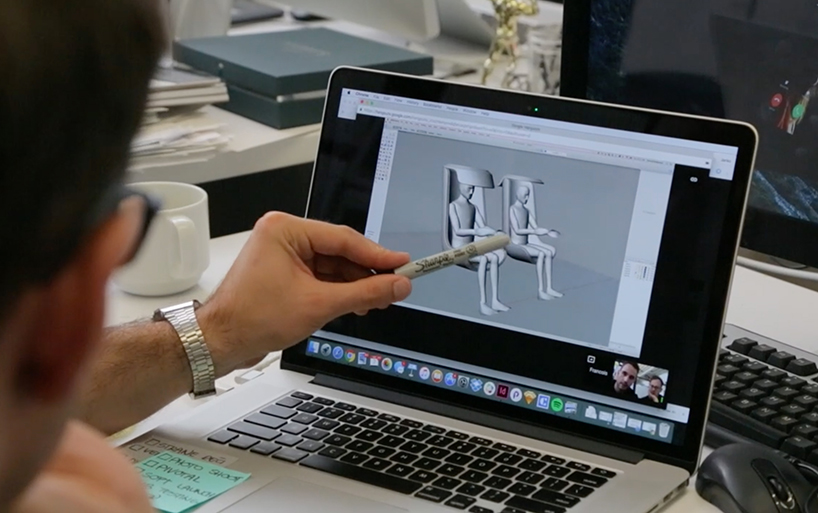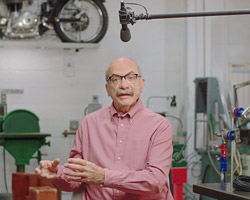a few weeks ago, IDEO revealed a new concept vehicle that considers the enormous potential for ride-sharing in our not-too-distant future. dubbed ‘the future of moving together’, the vision marks the fourth installment in IDEO’s ‘future of automobility’ series, following experiential visions for autonomous driving, on-demand delivery services, and mobile workspaces. complete with customizable ‘pods’, personalized reservation capabilities, and in-car adapted interfaces, this latest visualization imagines a more efficient, collaborative and flexible commute for drivers and passengers alike.
designboom spoke with janko potezica, senior design lead for IDEO’s mobility team, about the evolution of the project, the concept’s unique customization features, and where he thinks the ‘future of automobility’ is headed.

IDEO has been investigating ways to streamline the ride-sharing experience
designboom (DB): can you start by telling us a bit about your background, and how you first became involved in IDEO’s ‘future of automobility’?
janko potezica (JP): I had been working in the automotive industry for several years when I first came across IDEO’s future of automobility series. the concepts inspired me to rethink how I look at the future of cars, and more importantly, how I look at the future of mobility. it’s a really exciting time to be working in the space, and I joined IDEO to tackle some of the broader mobility challenges that we are facing today and push our thinking on how we might move people, things and spaces in the future. being an optimist by nature, it has always been important to me to inspire people through my work on what the future might hold. at IDEO it’s not long before you find other designers who share the same passion and are ready to take on a big challenge like this one.

the creative team envisioned a design that could suit a range of scenarios and user needs
DB: a few years ago, IDEO’s ‘future of automobility’ project resulted in three distinct concepts — exploring the time we spend commuting, autonomous package deliveries, and flexible work spaces. how has the ‘automobility’ project evolved since then?
JP: our team is in a unique position to identify trends across industries and spot behavioral shifts in society. the automobility series was inspired by three key behavioral trends: the on-demand economy, the sharing economy, and the attention economy. this means that we are increasingly expecting immediate access to goods and services, we favor access over ownership, and we are becoming more aware of how and when we consume information. the latest design concept in the automobility series considers these trends by zooming into the interior design of future ride-sharing vehicles. we believe that thoughtful interior design can enable a wide range of new interactions for those who are part of the shared mobility experience.
a look at ‘the future of moving together’
DB: rapidly advancing technological capabilities will be a given in the future, whereas basic humans needs to sleep, eat, work, and commute will remain the same. why were these the main concerns for IDEO’s automobility concepts, and how are you designing to cater for these needs?
JP: we envision future ride-sharing vehicles designed to meet both driver and passenger needs for relaxing, eating, or working on the road. we think we have to shift away from designing vehicles that take us from one space to another, and towards designing vehicles — and especially interiors — that move us from one space through another. some questions that we explored in the latest design concept included, ‘how might we create a personal sanctuary in moving spaces?’ and ‘how might we enrich social interaction within a shared vehicle?’ by placing users at the center, we have been able to prototype and design for a variety of scenarios and user needs.

four customizable pods are housed within each vehicle
DB: with urban infrastructures seemingly overwhelmed at present, how does ‘the future of moving together’ aim to ease city congestion?
JP: easing city congestion is a systemic challenge that has to be tackled with a spectrum of approaches, and IDEO’s automobility series offers some provocations on how we might tackle parts of this challenge. for example, work on wheels pods leverage unused infrastructure during the day and invert our commutes, while cody, the autonomous delivery vehicle, lowers congestion by operating during off-peak hours. the latest design concept highlights ways we can make ride-sharing a more attractive and efficient experience, which then has the potential to reduce the number of vehicles on the road. allowing car owners to rent out their vehicle during the day could further lower the burden on our parking infrastructures and open up space for other uses.

the concept looks at the potential future of ride-sharing
DB: ‘the future of moving together’ focuses on the potential of ride-sharing and aims to improve the service’s experience. what are some of the concept’s key features and how far away are we from actually experiencing these ourselves?
JP: with autonomous vehicles on the rise, we see a new language of mobility emerging where self-driving cars can express their intent to their surroundings through external indicators like displays and different lights. in shared mobility contexts today, finding the right car can be a challenge. as a possible solution, we imagine a future where people can personalize the outer appearance of their shared vehicle. we also thought about enhancing the shared mobility experience by allowing people to do more on the go, while avoiding motion sickness. each pod has a dedicated visor display, allowing riders to look forward and maintain situational awareness of the road while working or enjoying their favorite TV show. speech-driven interfaces in the visor displays can help passengers work and connect even more seamlessly with others while on the road. the technology for most of these concepts currently exists but some hurdles remain before we can see them implemented. we could conceivably see some of these designs on the road within the next decade.

‘the future of moving together’ imagines a more collaborative and flexible commute
DB: how would users be able to customize an experience inside the car, depending on their privacy preferences?
JP: we believe that unlocking the positive potential of shared mobility involves choice, or allowing people to customize their ride-sharing experience without limiting the experiences of others. for example, our design concepts allow riders to choose between a private or social experience in their personal pods. the pods include shells and noise-cancelling features that can provide visual and acoustic privacy. passengers can also engage in richer social interactions by tilting their pods towards each other and using acoustic amplification technology. the choice is entirely up to each rider. it’s easy to visualize a scenario where two passengers are having a lively conversation while another passenger might be working or relaxing in his or her own pod.

users can request on-demand reservations and customizable pods
DB: self-driving technology is an advancement that all automotive brands and many tech companies are testing. what are your own thoughts on the future of self-driving cars and the idea of an autonomous lifestyle in general?
JP: with so many automobile accidents today caused by human error, self-driving vehicles have the potential to make our roads much safer. the rise of electric, autonomous, connected, and shared fleets also has the potential to drop the cost per mile to a historic low, making physical mobility widely available. in the future, this might enable people to reach better opportunities in education, employment, or health-care that aren’t as accessible today. we see close ties between physical and social mobility, and lowering mobility costs might be an enabling factor to drive a new wave of prosperity throughout society.

from a smartphone, users can choose the pod they wish to travel in
DB: where is the future headed for IDEO’s exploration of the ‘future of automobility’?
JP: I was born in serbia, I grew up in germany, and now I’m living in california, and each of these places has a very unique mobility system in place with its own benefits and challenges. we are exploring a broad spectrum of mobility challenges at IDEO. we are especially excited about designing for mega-city mobility and tackling new challenges in developing economies – areas where design can play a significant role early on in infrastructure and in shaping how people, things and spaces move (and connect) at a systemic level.
IDEO (20)
PRODUCT LIBRARY
a diverse digital database that acts as a valuable guide in gaining insight and information about a product directly from the manufacturer, and serves as a rich reference point in developing a project or scheme.









